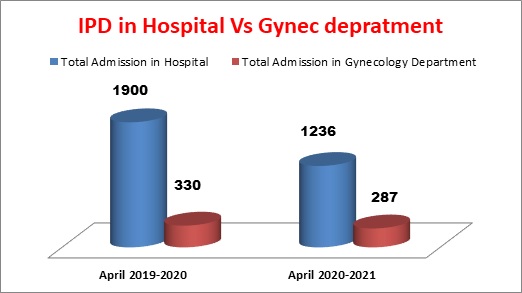A Study to decrease the incidence of PPH in our hospital setting
Abstract
Objective: This study aimed to measure incidence, identify risk factors (pre‐existing or acquired) for PPH and to prevent progression to severe PPH.
Methods: This is a prospective observational study. The causes are likely to be multifactorial with shifting demography and health status widely cited, e.g. age, obesity, comorbidity, multiple pregnancy and ethnicity.
Results: Prepregnancy factors for PPH include age, ethnicity, BMI, previous PPH and assisted conception
Conclusion: Prophylactic uterotonic agents in high-risk patients, use of intramuscular or intravenous oxytocin, timely application of B –lynch suture, adequate and timely arrangement of blood and blood factors can help prevent PPH.
Downloads
References
Buzaglo N, Harlev A, Sergienko R, Sheiner E. Risk factors for early postpartum hemorrhage (PPH) in the first vaginal delivery, and obstetrical outcomes in subsequent pregnancy. J Matern Fetal Neonatal Med. 2015 May;28(8):932-7. doi: 10.3109/14767058.2014.937698.
Briley A, Seed PT, Tydeman G, Ballard H, Waterstone M, Sandall J, et al. Reporting errors, incidence and risk factors for postpartum haemorrhage and progression to severe PPH: a prospective observational study. BJOG. 2014 Jun;121(7):876-88. doi: 10.1111/1471-0528.12588.
Gallos ID, Papadopoulou A, Man R, Athanasopoulos N, Tobias A, Price MJ, et al. Uterotonic agents for preventing postpartum haemorrhage: a network meta-analysis. Cochrane Database Syst Rev. 2018 Dec 19;12(12):CD011689. doi: 10.1002/14651858.CD011689.pub3.
Gilbert L, Porter W, Brown VA. Postpartum haemorrhage--a continuing problem. Br J Obstet Gynaecol. 1987 Jan;94(1):67-71. doi: 10.1111/j.1471-0528.1987.tb02255.x.
Sheiner E, Sarid L, Levy A, Seidman DS, Hallak M. Obstetric risk factors and outcome of pregnancies complicated with early postpartum hemorrhage: a population-based study. J Matern Fetal Neonatal Med. 2005 Sep;18(3):149-54. doi: 10.1080/14767050500170088.
Magann EF, Evans S, Hutchinson M, Collins R, Howard BC, Morrison JC. Postpartum hemorrhage after vaginal birth: an analysis of risk factors. South Med J. 2005 Apr;98(4):419-22. doi: 10.1097/01.SMJ.0000152760.34443.86.
Joshi VM, Otiv SR, Majumder R, Nikam YA, Shrivastava M. Internal iliac artery ligation for arresting postpartum haemorrhage. BJOG. 2007 Mar;114(3):356-61. doi: 10.1111/j.1471-0528.2006.01235.x.
McCormick ML, Sanghvi HC, Kinzie B, McIntosh N. Preventing postpartum hemorrhage in low-resource settings. Int J Gynaecol Obstet. 2002 Jun;77(3):267-75. doi: 10.1016/s0020-7292(02)00020-6.
Tort J, Rozenberg P, Traoré M, Fournier P, Dumont A. Factors associated with postpartum hemorrhage maternal death in referral hospitals in Senegal and Mali: a cross-sectional epidemiological survey. BMC Pregnancy Childbirth. 2015 Sep 30;15:235. doi: 10.1186/s12884-015-0669-y.
Grönvall M, Tikkanen M, Tallberg E, Paavonen J, Stefanovic V. Use of Bakri balloon tamponade in the treatment of postpartum hemorrhage: a series of 50 cases from a tertiary teaching hospital. Acta Obstet Gynecol Scand. 2013 Apr;92(4):433-8. doi: 10.1111/j.1600-0412.2012.01531.x.
Karoshi M, Keith L. Challenges in managing postpartum hemorrhage in resource-poor countries. Clin Obstet Gynecol. 2009 Jun;52(2):285-98. doi: 10.1097/GRF.0b013e3181a4f737.
Marshall AL, Durani U, Bartley A, Hagen CE, Ashrani A, Rose C, et al. The impact of postpartum hemorrhage on hospital length of stay and inpatient mortality: a National Inpatient Sample-based analysis. Am J Obstet Gynecol. 2017 Sep;217(3):344.e1-344.e6. doi: 10.1016/j.ajog.2017.05.004.
Abrams ET, Rutherford JN. Framing postpartum hemorrhage as a consequence of human placental biology: an evolutionary and comparative perspective. Am Anthropol. 2011;113(3):417-30. doi: 10.1111/j.1548-1433.2011.01351.x.
Karoshi M, Keith L. Challenges in managing postpartum hemorrhage in resource-poor countries. Clin Obstet Gynecol. 2009 Jun;52(2):285-98. doi: 10.1097/GRF.0b013e3181a4f737.
Kwast BE. Postpartum haemorrhage: its contribution to maternal mortality. Midwifery. 1991 Jun;7(2):64-70. doi: 10.1016/s0266-6138(05)80229-3.
Knight M, Callaghan WM, Berg C, Alexander S, Bouvier-Colle MH, Ford JB, et al. Trends in postpartum hemorrhage in high resource countries: a review and recommendations from the International Postpartum Hemorrhage Collaborative Group. BMC Pregnancy Childbirth. 2009 Nov 27;9:55. doi: 10.1186/1471-2393-9-55.

Copyright (c) 2021 Author (s). Published by Siddharth Health Research and Social Welfare Society

This work is licensed under a Creative Commons Attribution 4.0 International License.


 OAI - Open Archives Initiative
OAI - Open Archives Initiative



















 Therapoid
Therapoid

